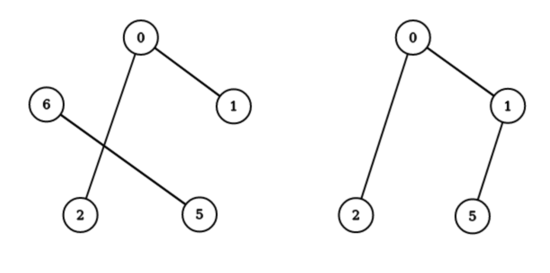CF1446C Xor Tree 题解 DP Trie树
Xor Tree
传送门
题面翻译
给定你一个非负整数序列
a
a
a,保证其中每个数两两不同。
对于每个
a
i
a _ i
ai?,它会向
j
≠
i
j \ne i
j=i 且
a
i
⊕
a
j
a_i\oplus a_j
ai?⊕aj?(
⊕
\oplus
⊕ 代表异或)最小的
a
j
a _ j
aj? 连双向边。
如果
a
j
a _ j
aj? 也向
a
i
a _ i
ai? 连了边,只算一条边。现在要让你删去序列中的一些数,使得最后形成的图是一颗树,输出最少需要删除几个数。
Translated by 试试事实上吗.
题目描述
For a given sequence of distinct non-negative integers ( b 1 , b 2 , … , b k ) (b_1, b_2, \dots, b_k) (b1?,b2?,…,bk?) we determine if it is good in the following way:
- Consider a graph on k k k nodes, with numbers from b 1 b_1 b1? to b k b_k bk? written on them.
- For every i i i from 1 1 1 to k k k : find such j j j ( 1 ≤ j ≤ k 1 \le j \le k 1≤j≤k , j ≠ i j\neq i j=i ), for which ( b i ⊕ b j ) (b_i \oplus b_j) (bi?⊕bj?) is the smallest among all such j j j , where ⊕ \oplus ⊕ denotes the operation of bitwise XOR (https://en.wikipedia.org/wiki/Bitwise_operation#XOR). Next, draw an undirected edge between vertices with numbers b i b_i bi? and b j b_j bj? in this graph.
- We say that the sequence is good if and only if the resulting graph forms a tree (is connected and doesn’t have any simple cycles).
It is possible that for some numbers b i b_i bi? and b j b_j bj? , you will try to add the edge between them twice. Nevertheless, you will add this edge only once.
You can find an example below (the picture corresponding to the first test case).
Sequence ( 0 , 1 , 5 , 2 , 6 ) (0, 1, 5, 2, 6) (0,1,5,2,6) is not good as we cannot reach 1 1 1 from 5 5 5 .
However, sequence ( 0 , 1 , 5 , 2 ) (0, 1, 5, 2) (0,1,5,2) is good.
 You are given a sequence
(
a
1
,
a
2
,
…
,
a
n
)
(a_1, a_2, \dots, a_n)
(a1?,a2?,…,an?) of distinct non-negative integers. You would like to remove some of the elements (possibly none) to make the remaining sequence good. What is the minimum possible number of removals required to achieve this goal?
You are given a sequence
(
a
1
,
a
2
,
…
,
a
n
)
(a_1, a_2, \dots, a_n)
(a1?,a2?,…,an?) of distinct non-negative integers. You would like to remove some of the elements (possibly none) to make the remaining sequence good. What is the minimum possible number of removals required to achieve this goal?
It can be shown that for any sequence, we can remove some number of elements, leaving at least 2 2 2 , so that the remaining sequence is good.
输入格式
The first line contains a single integer n n n ( 2 ≤ n ≤ 200 , 000 2 \le n \le 200,000 2≤n≤200,000 ) — length of the sequence.
The second line contains $ n $ distinct non-negative integers a 1 , a 2 , … , a n a_1, a_2, \ldots, a_n a1?,a2?,…,an? ( 0 ≤ a i ≤ 1 0 9 0 \le a_i \le 10^9 0≤ai?≤109 ) — the elements of the sequence.
输出格式
You should output exactly one integer — the minimum possible number of elements to remove in order to make the remaining sequence good.
样例 #1
样例输入 #1
5
0 1 5 2 6
样例输出 #1
1
样例 #2
样例输入 #2
7
6 9 8 7 3 5 2
样例输出 #2
2
提示
Note that numbers which you remove don’t impact the procedure of telling whether the resulting sequence is good.
It is possible that for some numbers b i b_i bi? and b j b_j bj? , you will try to add the edge between them twice. Nevertheless, you will add this edge only once.
以上来自洛谷 以上来自洛谷 以上来自洛谷
解题思路
可将问题转换为转化为求最大保留数,令只存在一对 ( i , j ) (i,j) (i,j) 对彼此而言 a i ⊕ a j a_i\oplus a_j ai?⊕aj? 的值都是最小的。
自然想到 Trie 树。(不会 Trie 树?看这里。)把所有数插入进 Trie 树里,递归考虑 Trie 树的一棵子树 x x x,记令子树 x x x 合法的最大保留数为 f x f_x fx?,子树 x x x 的左右儿子对应的是二进制意义下的第 k k k 位。
当子树 x x x 只存在左或右儿子时, f x f_x fx? 的值就是左右儿子的值,否则就是 max ? ( L e f t S o n . f , R i g h t S o n . f ) + 1 \max(LeftSon.f,RightSon.f)+1 max(LeftSon.f,RightSon.f)+1。因为在第 k k k 位之前,对应位的值都相同,仅第 k k k 位不相同,保留左右子树中的一棵,再保留其余子树的一个节点,就能确保当前子树内只存在一对上述的 ( i , j ) (i,j) (i,j)。最后答案就是 n ? f r t n?f_{rt} n?frt?。
#include <bits/stdc++.h>
using namespace std;
#define int long long
const int Maxn = 2e5 + 5;
int n, a[Maxn];
int rt, cnt;
int tong[4000005][2];
inline void Inst(int val) {
int tmp = rt, cur;
for (int i = 30; i >= 0; i--) {
cur = val >> i & 1;
if (!tong[tmp][cur]) {
cnt += 1;
tong[tmp][cur] = cnt;
}
tmp = tong[tmp][cur];
}
}
inline int Fac(int tmp) {
if (!tong[tmp][0] && !tong[tmp][1]) {
return 1;
}
if (!tong[tmp][0]) {
return Fac(tong[tmp][1]);
}
if (!tong[tmp][1]) {
return Fac(tong[tmp][0]);
}
return max(Fac(tong[tmp][0]), Fac(tong[tmp][1])) + 1;
}
inline void work() {
rt = cnt = 1;
cin >> n;
for (int i = 1; i <= n; ++i) {
cin >> a[i];
Inst(a[i]);
}
cout << n - Fac(rt) << endl;
}
signed main() {
ios::sync_with_stdio(false);
cin.tie(0);
cout.tie(0);
work();
return 0;
}
本文来自互联网用户投稿,该文观点仅代表作者本人,不代表本站立场。本站仅提供信息存储空间服务,不拥有所有权,不承担相关法律责任。 如若内容造成侵权/违法违规/事实不符,请联系我的编程经验分享网邮箱:chenni525@qq.com进行投诉反馈,一经查实,立即删除!
- Python教程
- 深入理解 MySQL 中的 HAVING 关键字和聚合函数
- Qt之QChar编码(1)
- MyBatis入门基础篇
- 用Python脚本实现FFmpeg批量转换
- Flutter开发 键盘弹起导致底部溢出问题
- HDFS概述
- web应用开发技术的一些概念
- 华为FusionStorage Block、OceanStor 100D、OceanStor pacific的区别
- [学习笔记]刘知远团队大模型技术与交叉应用L1-NLP&Big Model Basics
- Java医生咨询系统(源码+开题)
- YOLOv8改进 | 主干篇 | EfficientNetV2均衡缩放网络改进特征提取层
- SpringMVC使用步驟
- 自编码器的基本概念
- 二极管限幅电路理论分析,工作原理+作用